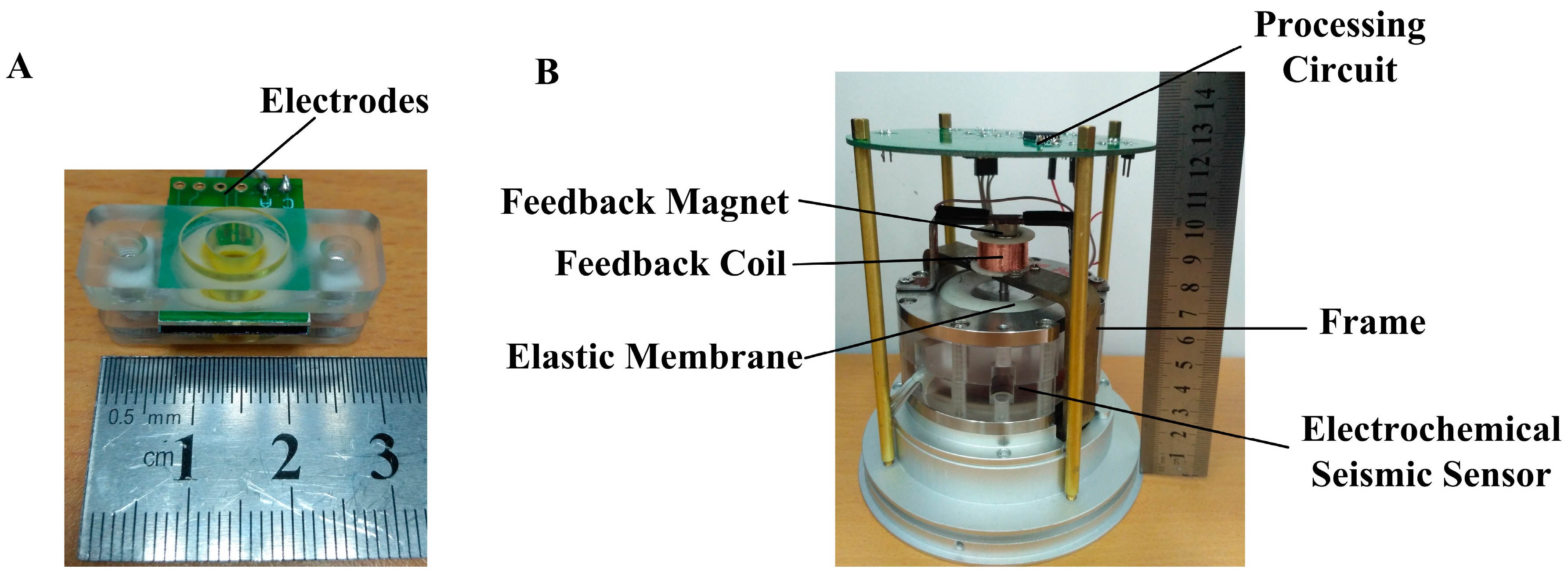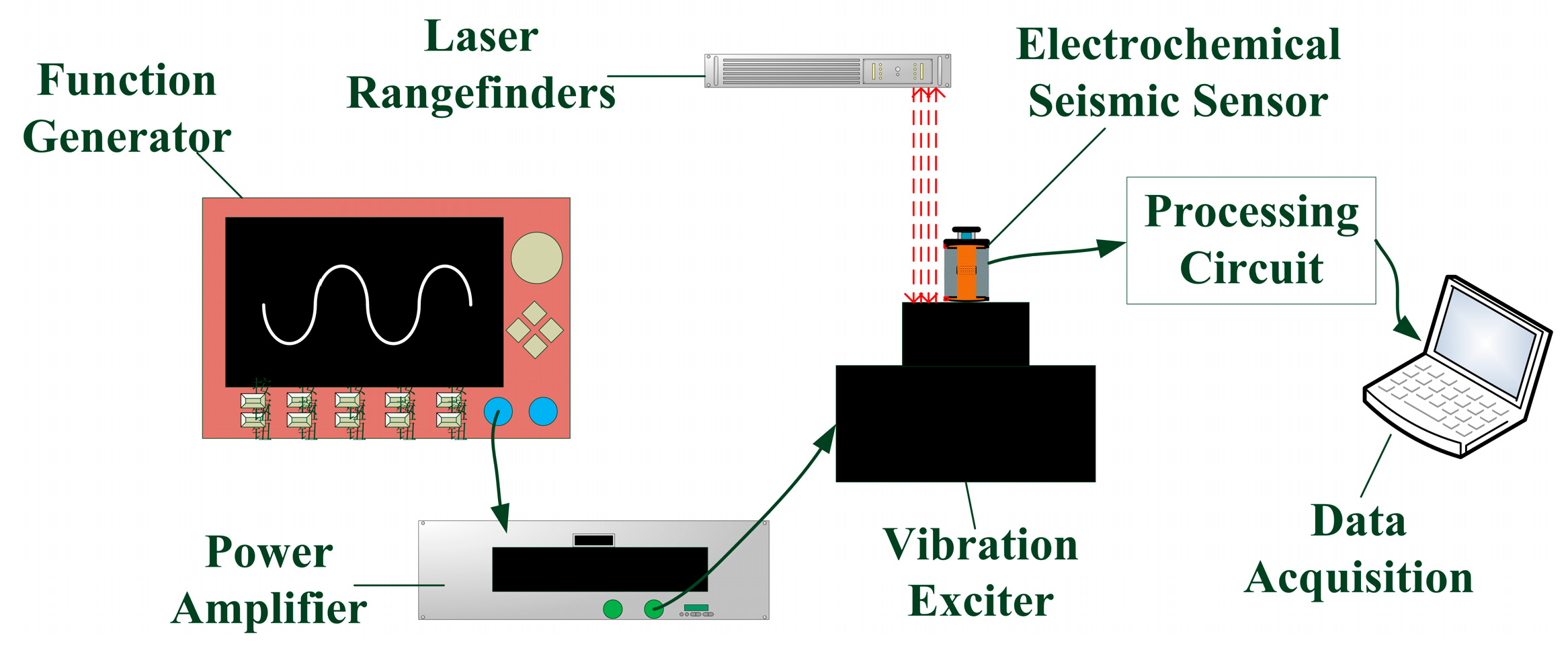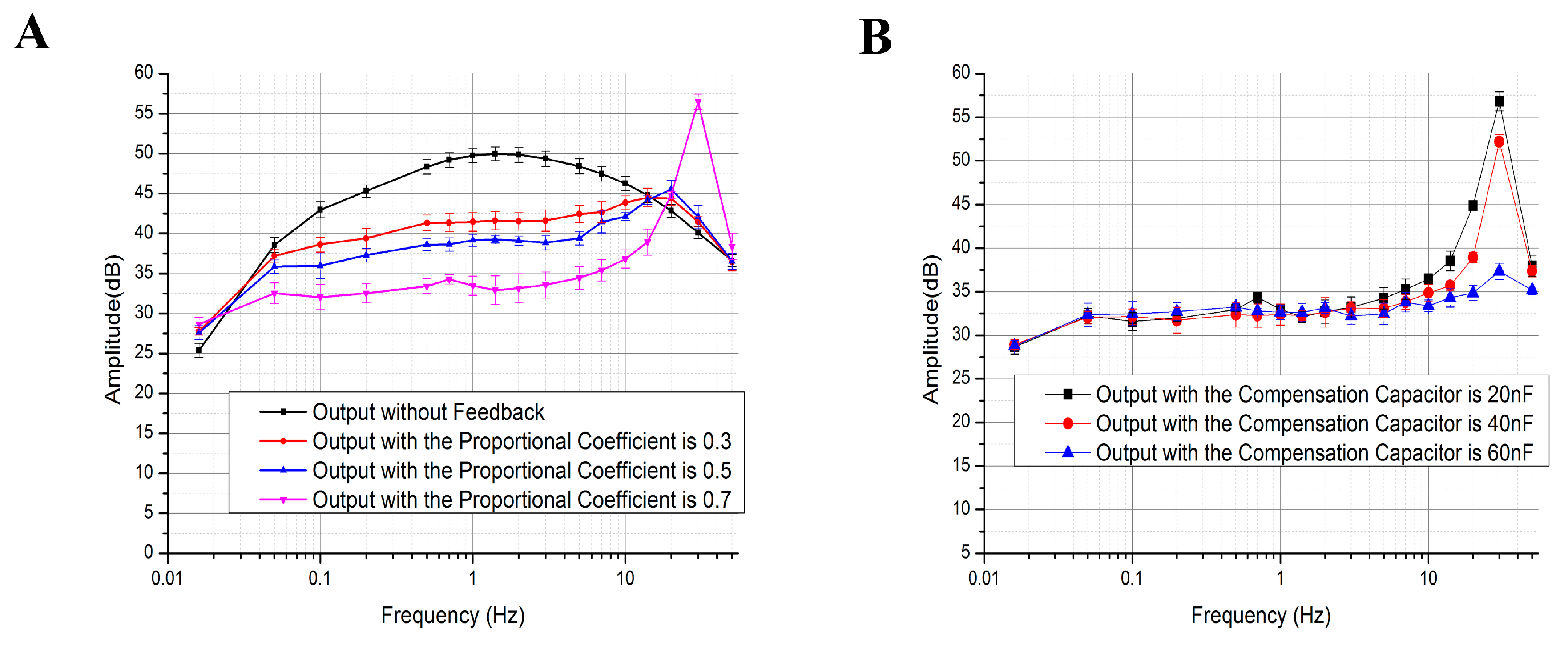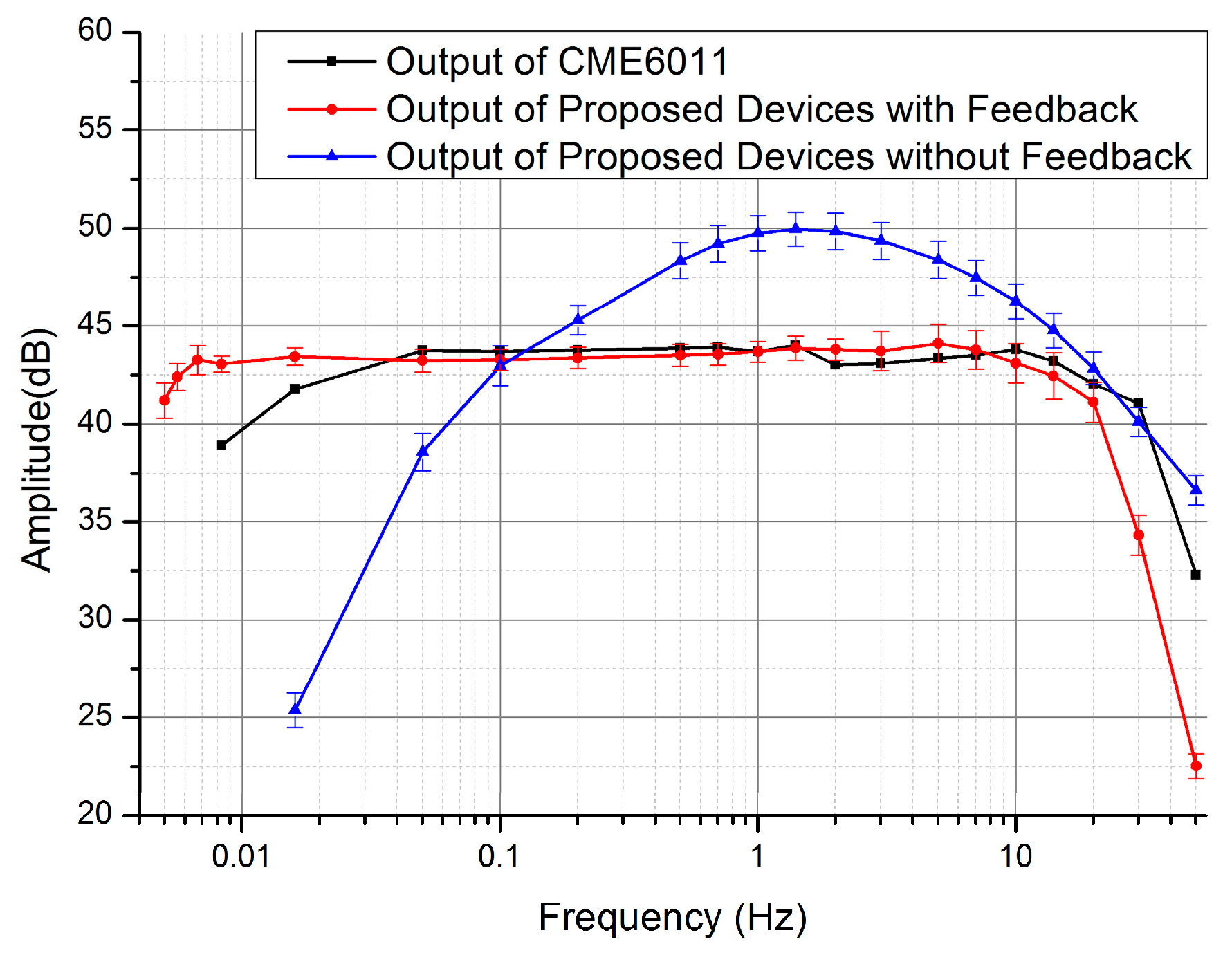An Electrochemical, Low-Frequency Seismic Micro-Sensor Based on MEMS with a Force-Balanced Feedback System
Abstract
:1. Introduction
2. Structure and Working Principle
3. Fabrication and Assembling
4. Experimental Characterization
5. Conclusions
Acknowledgments
Author Contributions
Conflicts of Interest
References
- Havskov, J.; Alguacil, G. Instrumentation in Earthquake Seismology; Springer: Dordrecht, The Netherlands, 2010; pp. 1–5. [Google Scholar]
- Niu, F.; Silver, P.G.; Daley, T.M.; Cheng, X.; Majer, E.L. Preseismic velocity changes observed from active source monitoring at the Parkfield SAFOD drill site. Nature 2008, 454, 204–208. [Google Scholar] [CrossRef] [PubMed]
- Herwijnen, A.V.; Schweizer, J. Monitoring avalanche activity using a seismic sensor. Cold Reg. Sci. Technol. 2011, 69, 165–176. [Google Scholar] [CrossRef]
- Zeng, R.; Lin, J.; Zhao, Y.J. Development situation of geophones and its application in seismic array observation. Prog. Geophys. 2014, 29, 2106–2112. [Google Scholar]
- Liu, Y.J. The Experiments and Studies on Broadband Electric Feedback Seismometer Based on KS-1 Pendulum (In Chinese); Institute of Earthquake Science, China Earthquake Administration: Beijing, China, 2009; pp. 1–2. [Google Scholar]
- Zhang, G.; Hu, S. Dynamic characteristics of moving-coil geophone with large damping. Int. J. Appl. Electromagn. 2010, 33, 565–571. [Google Scholar]
- Bakhoum, E.G.; Cheng, M.H.M. Frequency-selective seismic sensor. IEEE Trans. Instrum. Meas. 2012, 61, 823–829. [Google Scholar] [CrossRef]
- Kamata, M. Front end fidelity for seismic acquisition. In Proceedings of the 10th SEGJ International Symposium, Kyoto, Japan, 20–23 November 2011; pp. 1–4. [Google Scholar]
- Liang, T.C.; Lin, Y.L. Fiber optic sensor for detection of ground vibrations. Proc. SPIE 2012, 8351, 1–7. [Google Scholar]
- Jaroszewicz, L.R.; Krajewski, Z.; Teisseyre, K.P. Usefulness of AFORS—Autonomous fibre-optic rotational seismograph for investigation of rotational phenomena. J. Seismol. 2011, 16, 573–586. [Google Scholar] [CrossRef]
- Chistyakov, V.A. Portable seismic sensor. Seism. Instrum. 2011, 47, 8–14. [Google Scholar] [CrossRef]
- Bertolini, A.; DeSalvo, R.; Fidecaro, F.; Takamori, A. Monolithic folded pendulum accelerometers for seismic monitoring and active isolation systems. IEEE Geosci. 2006, 44, 273–276. [Google Scholar] [CrossRef]
- Milligan, D.J.; Homeijer, B.; Walmsley, R. An ultra-low noise MEMS accelerometer for seismic imaging. In Proceedings of the IEEE Sensors Conference 2011, Limerick, Ireland, 28–31 October 2011; pp. 1281–1284. [Google Scholar]
- Hons, M.; Stewart, R.; Lawton, D.; Bertram, M.; Hauer, G. Field data comparisons of MEMS accelerometers and analog geophones. Lead. Edge 2008, 27, 896–903. [Google Scholar] [CrossRef]
- Mougenot, D.; Thorburn, N. MEMS-based 3C accelerometers for land seismic acquisition: Is it time? Lead. Edge 2004, 23, 246–250. [Google Scholar] [CrossRef]
- R-Sensors LLC (Russia). Molecular-Electronic Broadband Seismometers: CME-60XX. Available online: http://r-sensors.ru/1_products/ Descriptions/CME-6011.pdf (accessed on 26 November 2014).
- Deng, T.; Chen, D.; Wang, J.; Chen, J.; He, W. A MEMS based electrochemical vibration sensor for seismic motion monitoring. J. Microelectromech. Syst. 2014, 23, 92–99. [Google Scholar] [CrossRef]
- Levchenko, D.G.; Kuzin, I.P.; Safonov, M.V.; Sychikov, V.N.; Ulomov, I.V.; Kholopov, B.V. Experience in seismic signal recording using broadband electrochemical seismic sensors. Seism. Instrum. 2010, 46, 250–264. [Google Scholar] [CrossRef]
- Hurd, R.M.; Lane, R.N. Principlis of very low power electrochemical control devices. J. Electrochem. Soc. 1957, 104, 727–730. [Google Scholar] [CrossRef]
- Wittenborn, A.F. Analysis of a logarithmic solion pressure detector. J. Acoust. Soc. Am. 1958, 30, 683. [Google Scholar] [CrossRef]
- Collins, J.L.; Richie, W.C.; English, G.E. Solion infrasonic microphone. J. Acoust. Soc. Am. 1964, 36, 1283–1287. [Google Scholar] [CrossRef]
- Larcam, C.W. Theoretical analysis of the solion polarized cathode acoustic linear transducer. J. Acoust. Soc. Am. 1965, 37, 664–678. [Google Scholar] [CrossRef]
- Abramovich, I.A.; Kharlamov, A.V. Electrochemical Transducers and a Method for Fabricating the Same. U.S. Patent 6576103B2, 10 June 2003. [Google Scholar]
- Huang, H.; Carande, B.; Tang, R.; Oiler, J.; Zaitsev, D.; Agafonov, V.; Yu, H. A micro seismometer based on molecular electronic transducer technology for planetary exploration. Appl. Phys. Lett. 2013, 102, 629–632. [Google Scholar] [CrossRef]
- He, W.T.; Chen, D.Y.; Wang, J.B.; Chen, J.; Deng, T. Extending upper cutoff frequency of electrochemical seismometer by using extremely thin Su8 insulating spacers. In Proceedings of the IEEE Sensors 2013, Baltimore, MD, USA, 3–6 November 2013; pp. 1–4. [Google Scholar]
- He, W.T.; Chen, D.Y.; Li, G.B.; Wang, J.B. Low frequency electrochemical accelerometer with low noise based on MEMS Key. Eng. Mater. 2012, 503, 75–80. [Google Scholar]
- Sun, Z.Y.; Chen, D.Y.; Wang, J.B.; Chen, J. A MEMS Based Electrochemical Seismometer with a Novel Integrated Sensing Unit. In Proceedings of the MEMS 2016 Conference, Shanghai, China, 24–28 January 2016; pp. 247–250. [Google Scholar]








© 2017 by the authors. Licensee MDPI, Basel, Switzerland. This article is an open access article distributed under the terms and conditions of the Creative Commons Attribution (CC BY) license (http://creativecommons.org/licenses/by/4.0/).
Share and Cite
Li, G.; Wang, J.; Chen, D.; Chen, J.; Chen, L.; Xu, C. An Electrochemical, Low-Frequency Seismic Micro-Sensor Based on MEMS with a Force-Balanced Feedback System. Sensors 2017, 17, 2103. https://doi.org/10.3390/s17092103
Li G, Wang J, Chen D, Chen J, Chen L, Xu C. An Electrochemical, Low-Frequency Seismic Micro-Sensor Based on MEMS with a Force-Balanced Feedback System. Sensors. 2017; 17(9):2103. https://doi.org/10.3390/s17092103
Chicago/Turabian StyleLi, Guanglei, Junbo Wang, Deyong Chen, Jian Chen, Lianhong Chen, and Chao Xu. 2017. "An Electrochemical, Low-Frequency Seismic Micro-Sensor Based on MEMS with a Force-Balanced Feedback System" Sensors 17, no. 9: 2103. https://doi.org/10.3390/s17092103
APA StyleLi, G., Wang, J., Chen, D., Chen, J., Chen, L., & Xu, C. (2017). An Electrochemical, Low-Frequency Seismic Micro-Sensor Based on MEMS with a Force-Balanced Feedback System. Sensors, 17(9), 2103. https://doi.org/10.3390/s17092103






